I hope you have been enjoying this series of toucan species special features as much as I have. With each new toucan whose life I get a chance to peek into, I am fascinated by the overall similarities of toucans in general, yet even more delighted by each bird’s unique personality. It has been so interesting to hear about the varying lifestyles of those who are fortunate to spend their lives with a toucan. In case you missed them, be sure to check out my interviews spotlighting our friends, Touk the Green Aracari and Pixie the Swainson’s toucan. Today’s interview features the toucan species most requested by those following this blog so far. I promise that you will not be disappointed with the character I’ve found to represent the Keel-billed toucans – a charming little firecracker named Pogo.
Keel-billed toucans, also known as Sulfur-chested or Rainbow-billed toucans, are a bit smaller than the two largest species, Tocos and Swainson’s, often weighing just under a pound with a slightly shorter, 5-inch beak. Due to their theatrical coloring, Keel-billeds are generally regarded as the most beautiful and aesthetically pleasing of all the toucan species, making them popular additions to zoos and other wildlife exhibits. Similar to our Toco toucans, Keel-billeds belong to the croaker family when it comes to noise-making abilities and are also not sexually dimorphic birds. Their native range encompasses most of Central America from Southern Mexico all the way down to Columbia and Venezuela.
Pogo the Keel-billed toucan hatched on June 4th, 2008 and found her flock shortly thereafter in Armando and Tonia. They all cohabitate together, for better or for worse, in the San Francisco Bay Area of Northern California. I connected with Tonia through You Tube, as one of the many fans of Pogo’s videos. Tonia is a wealth of knowledge and has become one of my favorite people to “talk toucans” with. Prepare to be enchanted with the unforgettable Pogo as you step into their life and get a glimpse of what it’s like to live under a Toucan Regime.
Hi, Tonia! Where did you adopt Pogo? How was your adoption process?
We arranged to get Pogo through Jerry Jennings of Emerald Forest Bird Gardens (EFBG) in Southern California beginning in early 2008. Jerry welcomed us to visit him when we were considering a toucan and he was very open and helpful to us. Since we were interested in a “pet quality”, hand-raised toucan, he arranged for a friend to bring in her Swainson’s toucan, so that we could interact with a pet bird, as Jerry’s toucans are generally paired up as breeders and display more “wild” behavior.
We were not committed to any particular species of toucan, but were leaning towards a large toucan since we have the space and time to care for one. Pogo would be our only pet and we do not have children. We hesitated on the choice of species long enough that we “missed” our window of opportunity to put a deposit down on a bird before the 2008 chicks were all claimed. We were saddened to think that another year would pass before we would get our bird, due to our indecision.
Fortunately, a month later, we got an email from Jerry saying that he had a “surprise” baby, the product of two very young Keel-billed toucans who had recently been paired. Jerry wasn’t really expecting any successful offspring from Pogo’s parents, but she survived her incubation and hatched into a healthy little chick.
In the past, I worked as a Wildlife Rescue Volunteer, hand-rearing orphaned or injured hummingbird and woodpecker chicks. I was very interested in finishing the hand-feeding process myself and worked with Jerry to let us take her home before she was fully weaned. We picked her up in San Diego when she was 7 weeks old and continued the hand-feeding twice daily for about one more month.
One of the most memorable parts of Pogo’s adoption was how she was introduced to us by Flavia, the young woman who hand-reared the toucan chicks at EFBG. She had just handed a baby Collared Aracari to my sister and described him as “The Darling of the Nursery”. Upon handing me Pogo, she said, “And this one? Well…” I believe that Flavia figured out Pogo’s personality within her first few weeks of life. We have learned that Keel-Billeds are feisty, active, and impudent – but we love her dearly anyway.
Check out this adorable video of baby Pogo – playful and spunky right from the start:
Have you owned birds prior to Pogo? How would you say toucans differ from your experiences?
Growing up, I had a number of companion birds- parakeets, lovebirds, and cockatiels. Pogo is nothing like those.
Pogo is more like a flying monkey, or what I imagine a flying monkey would be like – she’s always investigating her environment and getting into things. We have sayings at home that “a quiet toucan is one that is getting into trouble” and “never turn your back on a toucan”. If she is out of sight in the house, she is probably getting into something or making a mess. Other birds can be content in proper cages for periods of time, but Pogo wants/needs full run of our house and is fully-flighted (unclipped wings). She is definitely much more high maintenance and high energy than any other bird I have ever known well.
What is a typical day in your life with Pogo like?
Pogo sleeps in her “house”, a large cage in which I could stand-up in. She wakes with the first light, which is almost always earlier than Armando and I would normally get up. In her early years, she would “croak-croak-croak-croak” continuously until we got out of bed, exasperated, and began to interact with her. But we learned that we could bring her into our dark bedroom in the mornings to “sleep in” with us. She sits on a tabletop perch on our nightstand and goes back to sleep – sometimes until as late as 9 am. In an endearing way, she brings us Mazuri pellets (toucan food) in bed once she starts stirring. It seems to be part of the toucan ritual to give food gifts to your fellow flock members.
Whenever we all get up, Pogo is interacting with us just about every minute of the day. She supervises us in the kitchen while we wash out her food dishes and chop up fresh fruit: usually a mix of papaya, pear, grapes, strawberries, and avocado. We save her blueberries for food rewards or place them in foraging toys during the day so she has something to do when we are both away from home, working.
Anytime one of our family members is home, Pogo is reliably out of her cage and exploring the house or trying to participate in our activities. Sometimes she is content to sit still in the office for hours, watching Armando work from home. Other times, especially in the Spring when she is feeling “nesty”, she aggressively chases our feet and pecks them continuously. Our ankles show the scars of her handiwork, and we have learned that some footwear (particularly red slippers) sets her off more than other colors. Breeding season is always a challenging time with Pogo and we look forward to her summer molt after the summer solstice when her moody and often aggressive behavior mellows some.
Watch Pogo show her utter contempt for red slippers:
We joke that Pogo has a “staff” to care for her. Armando and I do her feeding, watering, and cage cleaning (including a sticky, stinky “big clean” about once per week). On days when we are both out of the house, my mother, Granny Bird, comes to visit to let Pogo out of her house and give her some interaction and flying time. Granny also does her share of cleaning up flung fruit, changing cage papers, and shopping for toucan fruit.
Evening time is often quiet time with Pogo. She enjoys sitting near us on the couch watching TV, listening to Armando play the piano while seated on his piano bench, or grooming herself on her “lamp perch” – it was once a nice swing-arm mica lamp, but is now fully converted to Pogo’s perch after she claimed it as her own and began to systematically destroy it.
Pogo often stays up until 9 pm or later, but lets us know that it’s time for bed by hopping near us and pointing her head straight up, towards the direction of her cage upstairs. Although she could hop up to her cage unassisted, she seems to like the ritual of involving us at bedtime. We carry her upstairs and she hops into her house, up to the highest perch where she disappears out of sight, nestled in the dark of her roofed cage.
Have you trained Pogo to do any special behaviors? If so, was it difficult?
Pogo is about 50% potty trained. We wish her success rate was higher since we still have lots of “accidents” that need cleaning each day. She seems to “forget” about pooping in the right places when something else has her interest or she isn’t adjacent to a perch and wants to stay nearby.
More successfully, I’ve trained her to fly on command, landing on an outstretched arm in exchange for a blueberry reward. This has been a useful “trick” because she will fly to any stranger who adopts the appropriate posture and offers a blueberry, including her avian vet and visiting friends who want to interact with Pogo or get a picture with her. My hope is that we could use this “trick” to retrieve her if she ever escaped outdoors.
What is your favorite thing about having Pogo in your lives?
Pogo makes us laugh. We joke that she is cheaper than a therapist.
We also really enjoy unraveling Pogo’s wild behaviors and learning to read her body language since we found so little available in print or online to help us interpret a “pet” toucan’s behavior. It is very interesting to cohabitate with a wild animal and it requires us to adapt to her behavior, unlike a domesticated animal that can adapt to our human habits. We will never be bored with Pogo in our lives, since she seems to teach us something new about “being a toucan” every week.
Watch Pogo’s natural foraging behavior with her very own signature toy – “Pogo’s Pockets” (I’ve got to make one (or three…) of these for the Three-Cans!):
What would you say is the most challenging thing about owning a toucan?
With Pogo, it is the moodiness, the constant demand for attention, and the mess. As I mentioned before, Spring is a tough time with Pogo. She has chosen Armando as her mate, which means that I am a competitor for his affection and get pecked more during this time of year. She follows Armando *everywhere* – yes, this can include the bathroom if he’s not careful. She alternately purrs and nuzzles with him, but moments later, she is pecking him and drawing blood.Some days, it seems she doesn’t know what she wants. Once I stopped interpreting her pecking as a personal affront, I felt better about her mood swings. It is most pronounced in Spring.
Pogo’s moodiness means that we are challenged to find bird sitters with the experience and courage to take on “one pound of angry, beaky, flapping bird”, which is what she can be in Spring or in the presence of bare feet – or red slippers. Fortunately, despite numerous nips and a black eye on one occasion, our dear bird sitter keeps coming back for more. We think she’s been seduced by Pogo’s good looks and her moments of endearing and sweet behavior too.
Like all pet birds, especially fruit-eating birds, Pogo makes a mess. She flings her food onto the floor, wall, whatever is nearby. Since she is an indoor bird, all that mess is inside our home, and not outdoors in an aviary. I spend a significant amount of time cleaning up after Pogo everyday. I have learned that indoor carnivorous plants are good managers of the fruit flies that can come with fruit-eating birds.
Would you recommend toucans as a pet? What would you tell someone before they chose to adopt one?
The big toucans, certainly Keel-Billed toucans, are high maintenance pets that require a lot of time, money, and patience – and unlike dogs, they are not good at responding to our human moods and whims. Toucans seem to march to the beat of their own drummer, driven by natural instincts and hormones. However, in the right home, with people who can appreciate their pet from more of a naturalist’s perspective, and where time, money, and patience are available, toucans are very rewarding companions and will keep you on your toes and learning constantly. It’s never boring and it’s never clean with a toucan.
My toucan gratitude goes Tonia, Armando, & Pogo for sharing such a fun, realistic picture of their lives together. All of the fantastic Pogo photos in this post were provided by Tonia and Armando. You can also find the Pogo videos shown here, as well as many others, on Pogo’s You Tube Channel – guaranteed to make you smile on even the roughest of days. There are still more toucan interviews coming soon – lucky for us toucans are quite a large, eclectic bunch!

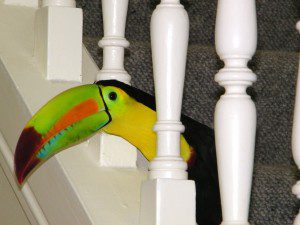
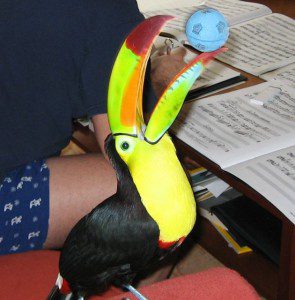
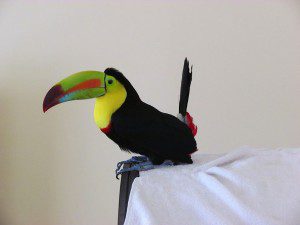


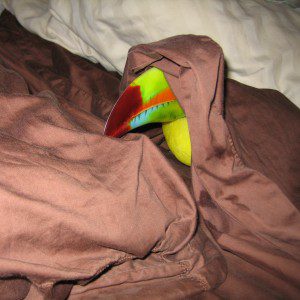

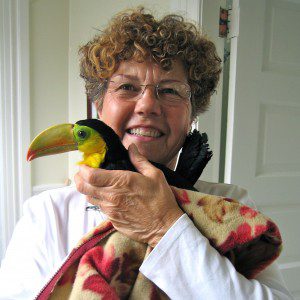

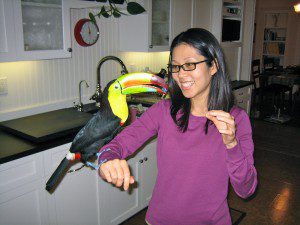
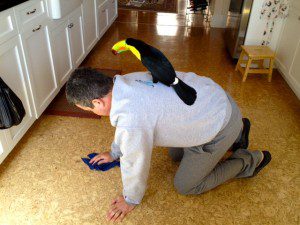



Pingback: Yoshi the Emerald Toucanet | Adventures in Toucanland
Tonia & Chrissann thank you for sharing Pogo’s story with us!!! 🙂
I thouroughly enjoyed Pogo’s story! I too share Tonia & Armando’s great love for a Keel-billed toucan, as I have ‘Chalupa’ (aka Chupie),a Keel that is 1 month younger than Pogo! I absolutely agree with their comments about the care, patience, attention, diet, behavior, affection, and mess of owning and interacting with such a unique ‘pet quality’ bird! Do not go out and adopt a toucan of any species because you just think they are beautiful, cool, and a crowd pleaser! You must be fully committed to full time care and patience with a toucan, especially the larger species like Chupie and Pogo! They require a very special diet that must be maintained throughout their lives. If you are in it for the long haul and are driven to learn as much about this species, then you’ve passed Step 1 of the thought of adoption. Keep a mindset that you will be mom and/or dad to a toddler for the life of this bird. My Chupie is only semi-tamed, therefore, a much more challenging road to travel. I made a decision to recently place Chupie with Jerry Jennings at Emerald Forest Bird Gardens as a potential mate to one of his female Keel-billed toucans, lonely for a companion. Because of his distaste of being handled, he would be a much happier Keel sharing time with a sweetheart! We love and miss him so much! Pogo’s story was such a comfort to me. Thanks so much for this great story!
Hi Adrienne, thanks for sharing! I have been following Chupie as he settles into EFBG on the yahoo group – he certainly seems like a happy guy in a great set-up, but I’m sure you miss him. I appreciate your feedback and am so glad you enjoyed the post. Tonia was great at sharing such a realistic picture of their life with Pogo. Best wishes to you & Chupie! ~Chrissann